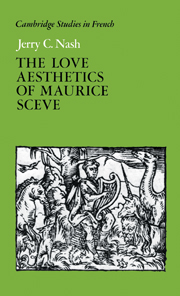Book contents
- Frontmatter
- Contents
- Preface
- 1 The problem of the dark side of a love poet: an introduction and reassessment
- 2 In search of love's epistemology: affirming the role of the creative imagination
- 3 Embodying the sacred and ineffable: poetic forms of transcendence and paradise
- 4 Becoming what one sees: the unity and identity of poetic self
- 5 Struggle, light, and love's “sainct lieu”
- 6 “De mes trauaulx me bienheurantz ma peine”: love poetry as therapy
- Epilogue Scève, Mallarmé, and the art of transcendence
- Notes
- Bibliography
- Index
- Cambridge Studies in French
4 - Becoming what one sees: the unity and identity of poetic self
Published online by Cambridge University Press: 22 August 2009
- Frontmatter
- Contents
- Preface
- 1 The problem of the dark side of a love poet: an introduction and reassessment
- 2 In search of love's epistemology: affirming the role of the creative imagination
- 3 Embodying the sacred and ineffable: poetic forms of transcendence and paradise
- 4 Becoming what one sees: the unity and identity of poetic self
- 5 Struggle, light, and love's “sainct lieu”
- 6 “De mes trauaulx me bienheurantz ma peine”: love poetry as therapy
- Epilogue Scève, Mallarmé, and the art of transcendence
- Notes
- Bibliography
- Index
- Cambridge Studies in French
Summary
This chapter is also about knowledge, the self-knowledge the poet acquires of the contemplating subject of love. Seeing and discovering, that is, creating a unity of sensuous form and spiritual idea in one's object of contemplation, not only permit a poet to merge the emotive meaning of love with its intellectual worth in intimate imaginings of harmony and beauty, but they also open up the even greater possibility for the poet-viewer to see and enjoy this same unity of mind and matter at work within the contemplating subject or self. An acquired unity and sense of order of exterior vision is what enables our love poet to acquire a sense of unity of interior vision. Scève, like Baudelaire and Valéry and other symbolist writers later on, felt that he could work upon the visions he experienced and communicate them in his poems, and even perhaps understand them in spite of the fact they might point to something contrary to, or above and beyond, logic. As Baudelaire would later put it, this paradisal perspective – be it outward vision of love object or inner vision of poetic self – is fundamentally a “call to order,” just as Valéry too would later view the process to be a “turning of disorder into order.”
- Type
- Chapter
- Information
- The Love Aesthetics of Maurice ScèvePoetry and Struggle, pp. 96 - 109Publisher: Cambridge University PressPrint publication year: 1991



